Abstract
The purpose of this study was to assess the relationship between the mother's interest in weight control and its association with the preschooler's obesity and weight related concerns. This was a cross-sectional study based on 470 parents' self-reports. To score interests in weight control, mothers rated each of 6 items on a five-point Likert scale ranging from disagree (1) to agree (5). The perceptions of mothers' weights and their children's weights, mothers' Body Mass Index (BMI), preschoolers' Weight-Length Index (WLI) (%), and weight-related concerns were determined. The mothers' BMI was significantly correlated with interest scores of weight control in mothers (r=0.632, p<0.001) while their children's obesity was weakly correlated with the mothers' interest scores (r=0.133, p=0.025). Mothers with a high interest of weight control reported higher percentages of family history of obesity than mothers with lower interests (63.2% vs. 36.8%, p<0.001). Two-thirds of the mothers (65.4%) were accurate in their perceptions about their weights. Similarly, 63.7% of mothers knew exactly their children's weight-statuses. Compared with mothers with low interest in weight controls, mothers with high interest in weight control had lower correct-perceptions about their weights (p<0.05) but higher correct-perceptions about their children's weights. More than two-thirds of mothers (85%) reported not worrying about their children's obesity in the future. Only 14.3% of the mothers were satisfied with their current weight statuses. Three-fourths of mothers preferred exercise as an effective weight-control method for their children, 20% preferred diet therapy and 5.5% preferred behavior modification. More girls were overweight / obese, than boys (overweight: 16.1% (girl) vs. 12.8% (boy), obese: 5.4% (girl) vs. 4.5% (boy)). About 40% of overweight girls' mothers had low interests in their weight controls with low correct-perceptions in their children's weights, which suggests possible elevated risk of obesity, especially in girls, in the future.
Being overweight is becoming one of the public health problems of childhood. There is growing concern that people may underscore increasing obesity rates in preschoolers (Francis & Birch, 2002; Kim et al., 2004; Klohe et al., 2007) According to the 2005 Korea National Health and Nutrition Examination Survey (KNHANES), the prevalence of overweight among children aged 6 through 9 years is 11.8%, which is alarming rate, compared to the obesity rate of 2.8% at aged 1-4 years (Ministry of Health & Welfare, 2006). Preschooler obesity can lead to increased health risks such as type 2 diabetes and cardiovascular diseases (Ball & McCarger, 2003).
Eating habits and a sedentary lifestyle are major environmental-factors for obesity. Mothers, at younger ages, have significant influences on their children's eating and life-style patterns. Several studies reported that childhood obesity is associated with maternal characteristics, especially with the mother's eating habits, nutrition knowledge, perceptions of their children's body sizes, and mother's depression (Birch et al., 2000; Birch & Fisher, 1998; Contento et al., 2003; Danielzik et al., 1999; Hood et al., 2000; Klohe et al., 2007). Mothers who used more eating prompts had children with improper eating habits (Abramovitz, 2003). Mothers concerned about their children becoming overweight were more likely to restrict their children's intake of specific foods and less likely to pressure their child to eat (Killion et al., 2006). A mother's misperception on their children's weights was also positively related to childhood obesity (Dubios et al., 2007; Hyun & Hong, 2005). Abramovitz & Birch (2000) reported that mother's dieting behavior contributed on their children's emerging ideas about dieting even at a younger age (Abramovitz & Birch, 2000; Fulkerson et al., 2002). Maternal dieting behaviors resulted in overemphasis on weight-control to their adolescents, suggesting these behaviors may lead to an increased risk for the development of obesity (Fulkerson JA et al., 2002).
Many of the above studies have assessed various factors separately regarding maternal diet or weight concerns and school aged children's obesity, but few have examined their relationships between interests in weight control and overweight in preschoolers. In Korea, some studies also have focused on the relationships between interests in weight control and nutrition knowledge or eating behavior or nutrition intakes in various subjects, not in preschoolers, such as young female adults, high-school girls, and housewives (Jung et al., 2003; Kim et al., 1998; Kim, 2004; Ryu et al., 1997).
Even with studies about preschoolers and obesity, (Choi & Youn, 2003; Kang, 2005; Kim et al., 2001; Kim et al., 2004; Lee & Youn, 1999; Lim, 2001), still little is known about maternal interests in weight control and its relationship with obesity in their children. The increasing overweight-rates among preschool-age children suggest that greater attention should be paid to this population, and various maternal factors related with preschooler's obesity need to be elucidated. Therefore, this study strived to explicate whether a mother's interest in weight control is associated with a preschooler's obesity and whether the extent of interests of weight control in mothers influence differently on weight-perceptions, dieting behaviors, and weight concerns for themselves or their preschoolers.
This was a cross-sectional study of 470 mothers of 23-60 months old children using a self-administered questionnaire. To obtain a sample of mothers from diverse socio-economic backgrounds, participants were recruited from 4 kindergartens in Seoul and its surrounding area between June 1, 2007 to June 30, 2007. Questionnaire items were developed and adapted from existing questionnaires (Jung, 2005; Kim, 2005; Park & Park, 2001). The questionnaire included items in 4 areas: 1) family demographics, 2) maternal interests about weight control, 3) the extent of obesity and related concerns for themselves and their children, and 4) maternal perceptions about their weight and their child's weight.
BMI was calculated from self-reported data according to the formula: weight (kg)/height (meters squared). According to IOTF guidelines (IOTF, 2000), respondents were classified into one of four groups: underweight (BMI<18.5), normal weight (BMI=18.5-22.9), overweight (BMI=23.0-25.0), and obese (BMI>25.0). The weight-length index (WLI) for the index of obesity in preschoolers was also calculated: [actual weight in kilograms ÷ actual height in centimeters/50th percentile expected weight in kilograms for age ÷ 50th percentile expected in height for age] (Durant & Linder, 1981). Preschoolers were classified as underweight (WLI<90%), normal weight (90%≦WLI<110%), overweight (110%≦WLI<130%), and obese (WLI≧130%) (Durant & Linder, 1981).
The questionnaire for assessing mothers' interests in weight control included 6 questions: caring about controlling weight, thinking about being thinner, thoughts for effective weight control, perception about current weight, caring about diet information, and number of diets tried. Parents were asked to evaluate in a five-point Likert scale ranging from unsatisfied (1) to very satisfied (5). After summing up scores, with a mean score of 21.25 ± 4.44, interest scores were divided into three categories: Low score (0-16), Medium score (17-24), High score (25-30).
Mothers were also asked about perceptions of their children's weights and concerns for the children's obesity, and these questions included: how they would describe their children's current weights (response options included underweight, about right, somewhat overweight or very overweight), whether they worried about their children's obesity, whether they generally cooked with weight concerns for children, preferred dieting methods when necessary, whether they always care about diet and nutrition information for their children (the response options were dichotomized into 'yes', 'no', and 'so-so').
To calculate the correct perception, the value of each response choice, such as "underweight (1)", "about the right weight (2)", "overweight (3)", or "very overweight (4)", was subtracted from their BMI score which was categorized into 4 groups: underweight (1), normal (2), overweight (3), obese (4). If the subtraction score was "O", the mother was considered to know exactly her weight status. Anthe score, such as -1, -2, 1, or 2, was considered as wrong perceptions of weight. The same calculations were also applied to determine the maternal perceptions of their children's weights. For demographic data, additional information, such as job status, feeding methods, education level, age, and family income was collected.
In all the analyses with the statistical package program of SPSS PC+, group differences between low, medium, and high scores were analyzed using One-way Analysis of Variance and Chi-Square test. Post-hoc tests such as the Tukey and LSD test were applied if there were significant differences among three groups. Spearman correlation coefficients were calculated between mother's interest scores in weight control, mother's or children's BMI, and other related measures, i.e. educational level, monthly income, feeding methods, job status, mothers' and perceptions of their child's weight. A two-tailed α-level of 0.05 was used for all statistical tests. The findings should be interpreted with caution due to the small sample sizes once the groups were split by three groups of interest scores (e.g. some cells contained less than n=10).
As shown in Table 1, there were no significant relationships between the extent of interest scores of weight control and mother's age, educational level, job status, or monthly family incomes. About 85% of mothers were aged between 20 and 30 years. Thirty-seven percent of mothers had a high school education or less and 74% were full-time housewives. About half of the subjects (49.9%) had a monthly family income of 3,000,000 won or more. Mothers who fed breast milk to their children and who were full time housewives had higher interest in weight control than the other groups, but no statistical significance was shown. Mothers with high interest scores of weight control reported higher percentage of family history of obesity than the low-scoring groups (63.2% vs. 36.8%, p<0.001). Mean of interest scores of weight control in mothers were 21.2 ± 4.4 with a range of 7 to 30 with 13.6 ± 3.3 in Low score, 20.7 ± 4.1 in Medium score, and 26.6 ± 1.6 in High score, respectively (p<0.05).
According to BMI, 24.5% of mothers studied were overweight or obese and rest of mothers were either normal-weight or underweight (p<0.05). Mothers with high scores in weight control were significantly heavier (BMI: 23.08 ± 2.47) than mothers who had low or medium interest scores of weight control (BMI: 21.29 ± 1.84 in Medium score or BMI: 19.69 ± 1.74 in Low score, p<0.05). When overweight was defined for children as WLI obesity index (%), 14.4% of children were overweight, with the values of 4.9% obese, 65.6% normal weight, 15.1% underweight. Two-thirds of mothers (65.4%) were accurate in their perceptions about their own weights. Similarly, 63.7% of mothers exactly knew about their children's weight statuses. Interestingly, mothers with high interest scores of weight control had lower correct perceptions for their weights than mothers with low interests of weight control (63.2% vs. 73.4%, p<0.001). Opposite trends were shown in maternal perception of their children's weights. In mothers with low interest scores of weight control, 44% of mothers falsely perceived their children's weight statuses compared to 29.7% of wrong perception rates in mothers with high interest scores.
In all subjects, the mother's obesity was significantly correlated with interest scores of weight control (r=0.632, p<0.001, Fig. 1). It was evident from this figure that the BMI of mothers and the interests in controlling their weights showed a positive linear relationship.
Fig. 2 showed weak correlation between WLI obesity index
(%) of preschoolers and mother's interest scores of weight
controls, although some trends that higher percentages of
overweight/obese children included in higher scores of weight
controls were shown (r=0.133, p=0.025).
No statistical gender differences between WLI obesity index and interest-scores of weight control in mothers were shown (Table 3). Among total preschoolers, more girls were overweight or obese than boys (overweight: 16.1% (girl) vs. 12.8% (boy), obese: 5.4% (girl) vs. 4.5% (boy)). In boys, mothers with high interest scores of weight control had high percentages of overweight (15.2%) and obese sons (9.1%), compared with mothers with low interest score with low percentages of overweight sons (2.3%). Interestingly in mothers with overweight girls, 41.7% (10/24) reported low interest in weight control of themselves. Mothers with obese girls showed either medium (75%, 6/8) or high interest scores (25%, 2/8) of weight controls. Meanwhile, mothers of underweight girls (48.1%, 13/27) or normal-weight girls (33.1%, 5/18) reported high interest in weight control.
More than two-thirds of mothers (85%) reported not worrying about their children's obesity in the future. Mothers' interests in weight control were significantly associated with a variable worrying about their children's weight-gaining in the future (26% vs. 11.8% (medium score) or 5.9% (low score), p<0.05). About half of mothers (48.1%) generally cooked at home with concerns about their children's weights and 60% of mothers generally cared about nutrition/ diet information about children. However, there were no significant differences between preparing low calorie foods or obtaining diet/ nutrition information and interest scores of weight control in mothers. As for weight controlling methods, if necessary, most mothers (85%) preferred exercise as an effective intervention. Only 9% of mothers considered calorie reduction and 6% of mothers considered behavior modification.
About one-third of mothers (28.3%) had no experience of weight control, while 53% of mothers reported that they tried to lose weight one or more times. Mothers with high interest of weight control had dieted 3 times or more (63.9% vs. 13.2% (Medium) or 0.7% (Low), p<0.05). In addition, mothers with high interest in weight control also showed significantly higher desire to lose weight than mothers with low interest scores (80.5% vs. 40.8%). On average 62% of the subjects wanted to lose some weight from their current weights. Only 14.3% of the subjects were satisfied with their current weight statuses. 75% of the subjects preferred exercise as effective dieting methods, 20% diet therapy and 5.6% behavior modification. Mothers with high interest in weight control chose more behavior modification (8.3%) as preferred dieting regimens, compared with mothers with either low (3.6%) or medium interest scores (5.1%) in weight controls.
Weight-controlling behaviors of mothers were associated with their teenager's obesity and dieting behavior. Therefore, this study tried to determine whether the mother's interest of weight control is related with the preschooler's obesity and obesity-related concerns. Mothers with high interests in weight control had a higher family history of obesity (Table 1, p<0.05) and higher BMI (Fig. 1, r=0.632). From this result, we can suggest that mothers' high interest in weight control and high BMI may come from a history of obesity within the family. It is well published that genetic factors are contributing factors for the development of obesity (Francis et al., 2002; Johnson & Birch, 1994; Lee et al., 2000). Gibeson et al. (2007) suggested that having an overweight mother and coming from a single mother increased the likelihood of a child being overweight or obese.
In this study, mothers with high interests in weight control were also found to have higher percentage of overweight preschoolers, compared to mothers with low interests (p<0.05). Mothers' interests in weight control were significantly but weakly correlated with their children's obesity index (r=0.133, p=0.025, Fig. 2). Mothers with high interest scores of weight control, also reported very much worrying about their children's weights (Table 4), having higher corrected perception of children's weights, compared to mothers with low interests about weight controls (Table 2). Since the nature of cross-sectional study, we can't explain the origin of this association. Nevertheless, we can suggest that mothers who have a family history of obesity and thus have high interests in weight control for themselves will also try to maintain a healthy weight in an obesogenic environment which lead to more attentions to their children's weight and thus have high corrected-perceptions for their children's weight (Gibeson et al., 2007). Thus, maternal interests in weight control and maternal BMI may be factors that influence on childhood obesity.
As seen in Table 3, mothers with low interest in weight control had 41% of overweight girls (10 out of total 24 overweight girls), while mother's weights were either underweight (65%) or normal weight (22.6%) (Table 2). Mothers with low interest in weight control also shown to have lower correct-perceptions about their children's weights compared to mothers with high interest in weight control (55.6% vs 70.3%). Because mothers of overweight girls have no weight problems; they might think there are few possibilities for their children to be obese in the future (Baughcum et al., 2000). Mothers may also believe even if their children's weights are slightly above the recommended standard, it is beneficial for the children in terms of growth and development (Baughcum et al., 1998). Several studies showed that a parent's misperception of their children was associated with their BMI and children's obesity (Baughcum et al., 1998; Baughcum et al., 2000; Contento et al., 2003; Davison et al., 2000; Hyun & Hong, 2005). A mother's concern of controlling food intake can reduce obesity in childhood (Birch & Fisher, 2000; Danielztk et al., 1999; Johnson & Birch, 1994; Robinson et al., 2001). Therefore, mothers with overweight children should be aware of their children's exact weight statuses, and need to have more interest in their children's eating habits and weights.
Our studies had some limitations. First, since we used obesity index according to the mothers self reported-data, using the reported BMI of mothers WLI obesity index of preschoolers are limited. Second, the widespread emphasis on weight concerns may have led mothers to under or over - report when asked about weight related questions. Further studies including other possible maternal factors such as parenting skills, maternal psychological problems, and obesity related stresses are needed to clarify maternal influence on childhood obesity. In particular, longitudinal data is essential to clarify how parental influences may contribute to subsequent childhood obesity.
In summary, high interests of weight controls in mothers are greatly associated with family history of obesity, mother's BMI, and preschooler obesity. Although some mothers with high interests in weight control reported worrying about childhood obesity, most mothers in this study seemed not to worry about their children's weights as much as their own weight interests. Special attention is perhaps needed for overweight girls with overweight mothers who have low interest in their weight controls.
References
1. Abramovitz BA, Birch LL. Five-year-old girls' ideas about dieting are predicted by their mothers' dieting. J Am Diet Assoc. 2000; 100:1157–1163. PMID: 11043700.

2. Abramovitz BA, Birch LL. Learning to overeat: maternal use of restrictive feeding practices promotes girls' eating in the absence of hunger. Am J Clin Nutr. 2003; 78:215–220. PMID: 12885700.
3. Ball GDC, McCarger LJ. Childhood obesity in Canada: A review of prevalence estimates and risk factors for cardiovascular diseases and type 2 diabetes. Can J Appl Physiol. 2003; 28:117–140. PMID: 12671200.

4. Baughcum AE, Chamberlin LA, Deeks CM. Maternal perceptions of overweight children. Pediatrics. 2000; 106:1380–1386. PMID: 11099592.
5. Birch LL, Fischer JO. Development of eating behaviors among children and adolescents. Pediatrics. 1998; 101:539–549. PMID: 12224660.

6. Birch LL, Fisher JO, Davison KK. Five-year-old girls' ideas about dieting are predicted by their mothers' dieting. J Am Diet Assoc. 2000; 100:1157–1163. PMID: 11043700.
7. Choi MJ, Yoon JS. The effect of eating habits and nutrient intake on the physical growth indices in preschool school. Korean Journal of Community Nutrition. 2003; 8:3–14.
8. Chung YJ, Han JI. Prevalence of obesity, eating habits and parents characteristics of 5th grade elementary school boys in Taejon city. Korean Journal of Nutrition. 2000; 33:421–428.
9. Contento IR, Basch C, Zybert P. Body image, Weight, and food choices of Latina women and their young children. J Nutr Educ Behav. 2003; 35:236–248. PMID: 14521823.

10. Costanzo PR, Woody EZ. Domain-specific parenting styles and their impact on the child's development of particular deviance: the example of obesity proneness. J Soc Clin Psychol. 1985; 3:425–445.

11. Cutting TM, Fisher JO, Grimm-Thomas K, Birch LL. Like mother, like daughter: familial patterns of overweight are mediated by mothers' dietary disinhibition. Am J Clin Nutr. 1999; 69:608–613. PMID: 10197561.

12. Davison KK, Markey CN, Birch LL. Etiology of body dissatisfaction and weight concerns among 5-year-old girls. Appetite. 2000; 35:143–151. PMID: 10986107.

13. Drucker RR, Hammer LD, Agras WS, Bryson S. Can mothers influence their child's eating behavior? J Dev Behav Pediatr. 1999; 20:88–92. PMID: 10219686.

14. Dubois L, Girad M. Accuracy of maternal reports of pre-schoolers' weights and heights as estimates of BMI values. Int J Epidemiol. 2007; 36:132–138. PMID: 17510077.

15. Durant R, Linder CW. An evaluation of five indexes of relative body weight for use with children. J Am Diet Assoc. 1981; 78:35–41. PMID: 7217558.

16. Epstein LH, Valoski A, Wing RR, McCurley J. Ten-year follow up of behavioral, family-based treatment for obese children. JAMA. 1990; 264:2519–2523. PMID: 2232019.
17. Francis LA, Birch LL. Impact of parental BMI on the manifestation of overweight 5-7 year old children. Eur J Nutr. 2002; 41:132–138. PMID: 12111051.
18. Freedman DS, Dietz WH, Srinivasan SR, Berenson GS. The relation of overweight to cardiovascular risk factors among children and adolescents: the Bogalusa Heart Study. Pediatrics. 1999; 103:1175–1182. PMID: 10353925.

19. Fulkerson JA, McGuire MT, Neumark-Sztainer D, Story M, French SA, Perry CL. Weight-related attitudes and behaviors of adolescent boys and girls who are encouraged to diet by their mothers. International Journal of Obesity. 2002; 26:1579–1587. PMID: 12461674.
20. Gibson LY, Byrne SM, Davis EA, Blair E, Jacoby P, Zubrick SR. The role of family and maternal factors in childhood obesity. Med J Aust. 2007; 186:591–595. PMID: 17547550.

21. Golan M, Weizman A, Apter A, Fainaru M. Parents as the exclusive agents of change in the treatment of childhood obesity. Am J Clin Nutr. 1998; 67:1130–1135. PMID: 9625084.

22. Gortmaker SL, Must A, Perrin JM. Social and economic consequences of overweight in adolescents and young adulthood. N Engl J Med. 1993; 329:1008–1012. PMID: 8366901.
23. Hood MY, Moore LL, Sundarajan-Ramamurti A, Singer M, Cupples LA, Ellison RL. Parental eating attitudes and the development of obesity in children. The Framingham Children's Study. Int J Obes Relat Metab Disord. 2000; 24:1319–1325. PMID: 11093294.

24. Hyun WJ, Hong YJ. Personal Maternal Body Image Perceptions Their Preschool Children. Korean Journal of Community Nutrition. 2005; 10:930–942.
25. International Obesity Task Force. Report on the Asia-Pacific perspective: redefining obesity and its treatment. 2000. Sydney. Australia: International Obesity Task Force;p. 12–25.
26. Johnson SL, Birch LL. Parent's and children's adiposity and eating style. Pediatrics. 1994; 94:653–661. PMID: 7936891.

27. Jung IK, Kwan SO, Han IK, Lee IH. A study on perceptions on body image and weight control method in Korean women. Korean Society of Community Nutrition Conference Proceeding. 2003. p. 4–8.
28. Jung MS. The comparison of obesity-related stress, diet habit, level of nutrition knowledge and level of quality of life on environment of life for middle aged women. 2005. Dongduck University of Korea;Master's Thesis.
29. Kang KJ. A study on food habits, nutrient intakes and nutritional quality of preschool children in Seoul. Korean Journal of Community Nutrition. 2005; 10:471–483.
30. Killion L, Hughes SO, Wendt JC, Pease D, Nicklas TA. Minority mothers' perceptions of children's body size. Int J Pediatr Obes. 2006; 1:96–102. PMID: 17907321.

31. Kim HS, Lee JR, Lee TH, Nam OK. Health problems and health behaviors of preschoolers. Journal of Korean Academy Nursing. 2004; 34:182–190.

32. Kim MK, Kim HJ, Kim YO, Lee JH, Lee WC. Overweight among preschool children in Seoul: Prevalence and Associated factors. Korean Journal of Community Nutrition. 2001; 6:121–129.
33. Kim SM. The study of body image and appearance-management behaviors according to trial or not and weight control method of college women. 2005. Dongkuk Women's University of Korea;Master's Thesis.
34. Kim KW, Lee MJ, Kim JH, Shim YH. A study on weight control attempt and related factors among female college students. Korean Journal of Community Nutrition. 1998; 3:21–33.
35. Kim SY. The ecological factors related to completion of weight reduction program in the obese premenopausal women. Korean Journal of Community Nutrition. 2004; 9:683–694.
36. Klohe-Lehman DM, Freeland-Graves J, Anderson ER, McDowell T, Clarke KK, Hanss-Nuss H, Cai G, Puri D, Milani TJ. Maternal influences on daughters' restrained eating behavior. Health Psychol. 2005; 24:548–554. PMID: 16287400.
37. Klohe-Lehman DM, Freeland-Graves J, Clarke KK, Cai G, Voruganti VS, Milani TJ, Nuss HJ, Proffitt JM, Bohman TM. Nutrition knowledge is associated with greater weight loss in obese and overweight low-income mothers. J Am Diet Assoc. 2006; 106:65–75. PMID: 16390668.

38. Klohe-Lehman DM, Freeland-Graves J, Clarke KK, Cai G, Voruganti VS, Milani TJ, Nuss HJ, Proffitt JM, Bohman TM. Low-income, overweight and obese mothers as agents of change to improve food choices, fat habits, and physical activity in their 1-to-3-year-old children. J Am Coll Nutr. 2007; 26:196–208. PMID: 17634164.

39. Lee JB, Oh LJ, Kim SW, Kang JH, Yang YJ. The prevalence and risk-factors of childhood obesity in elementary students in Seoul. Journal of Korean Academy Family Medicine. 2000; 21:866–875.
40. Lee KH, Yoon SY. Analysis of anthropometic and clinical data in obese children in Changwoon. Journal of Korean Society of Food Science and Nutrition. 1999; 28:1164–1171.
41. Lee MJ, Kim SK, Chang KJ. Dietary behaviors, health-related lifestyle and blood lipid profiles of obese children in Incheon. Korean Journal of Community Nutrition. 2002; 7:803–813.
42. Lim HJ. Assessment of dietary intake of preschool children in Busan: Assessment based on food Group intake. Korean Journal of Community Nutrition. 2001; 6:3–15.
43. Ministry of Health and Welfare. The Third Korea National Health and Nutrition Examination Survey (KNHANES III). 2006. Seoul. Republic of Korea: Ministry of Health and Welfare;p. 55–60.
44. Park SJ, Park YJ. A study of concern about weight control, eating behavior. Journal of East Asian Association of Dietary Life. 2001; 201:356–367.
45. Rhu HK. A study of adolescents' concern and perception about body image-At Miryang City. Korean Journal of Community Nutrition. 1997; 2:197–205.
46. Robinson TN, Kiernan M, Matheson DM, Haydel KF. Parental Control over Children's Eating Associated with Childhood Obesity? Results from a Population-Based Sample of Third Graders. Obesity Research. 2001; 9:306–312. PMID: 11346672.
47. Rosner B. Fundamentals of Biostatistics. 2000. Fifth Edition. New York. USA: Duxbury Press;p. 45–60.
48. Saelens BE, Ernst MM, Epstein LH. Maternal child feeding practices and obesity: a discordant sibling analysis. Int J Eat Disord. 2000; 27:459–463. PMID: 10744853.

49. Tershakovec AM, Weller SC, Gallagher PR. Obesity, school performance and behavior of black, urban elementary school children. Int J Obes. 1994; 18:323–327.
50. You JS, Choi YJ, Kim IS, Chang KJ, Chyun JH. A study on prevalence of obesity, eating habits and life styles of the 5th grade students in Inchon. Korean Journal of Community Nutrition. 1997; 2:13–22.
Fig. 2
The correlations between the WLI obesity index of preschooler and interest scores of weight controls in mothers.
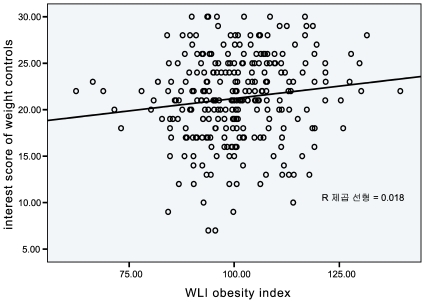
Table 2
Obesity index and weight-perception rate according to interest scores of weight control in mothers
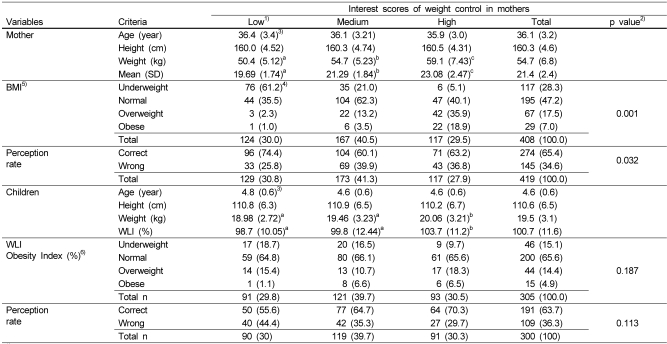
1)Low score: 10-16, Medium score: 17-24, High score: 25-30
2)p value: significance at p<0.05 by chi-square test
3)mean and standard deviation
4)number of subjects (percentage)
5)BMI (Body Mass Index) = weight (kg)/height (meters squared).
6)WLI (weight-length index)2 = [actual weight in kilograms ÷ actual height in centimeters/50th percentile expected weight in kilograms for age ÷ 50th percentile expected in height for age]
a,b,cDifferent letters, a, b, & c, donate significant difference among groups, (Low-Score, Medium-Score, and High-Score) at p<0.05 level.
Table 3
The relationships between WLI obesity index of preschoolers and interest scores of weight control in mothers n (%)
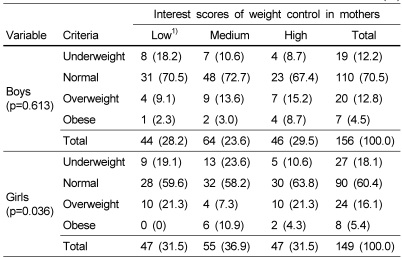




 PDF
PDF ePub
ePub Citation
Citation Print
Print


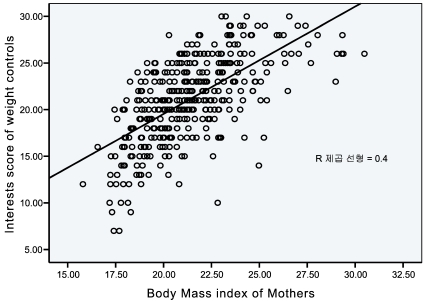
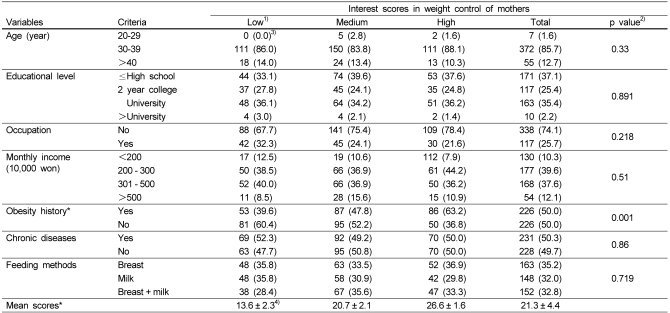
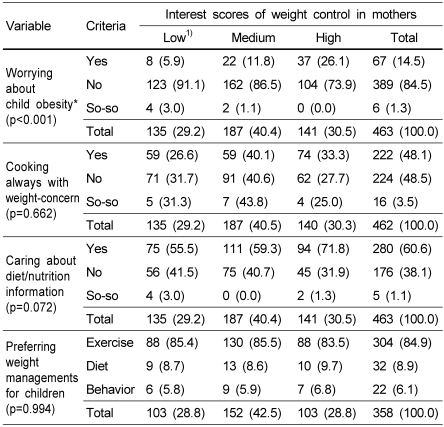
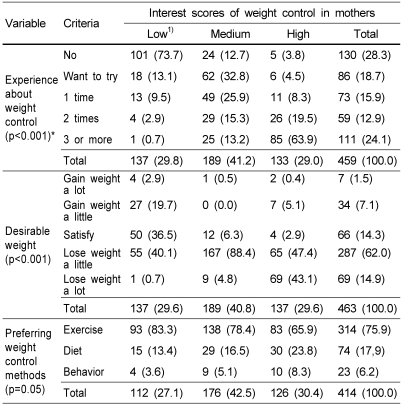
 XML Download
XML Download